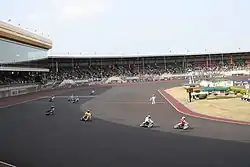Auto Race (Japanese sport)
Auto Race (オートレース, Ōto Rēsu) is a Japanese version of flat track motorcycle racing, but combines gambling added into it and is held on an asphalt course, throughout Asia. It is regulated by the JKA Foundation.
 Auto Race competitors cross the finish line at Kawaguchi Auto Race Circuit | |
| Characteristics | |
|---|---|
| Contact | Contact |
| Type | Outdoor |
Paved flat track is predominantly a gambling sport. The first ever meeting was held at Funabashi in 1950, but the more traditional speedway and flat track dirt surfaces were banned by the government in the 1960s because they were considered too dangerous.
Unlike other forms of motorcycle and gambling sport, prior to race day, riders are required to reside at the dormitory with over 500 riders and refrain from contacting anyone within the outside world including any forms of communications to prevent race fixing, which scandalised the sport during the years of the sport when the Yakuza took over the sport, most notably the Black Mist Scandal where NPB players and flat track racers conspired to manipulate races; as a result, crowds dwindled and it was saved when a motorcycle federation took it over in 1967. Since then the sport has very much gone its own way to develop into a form of motor sport exclusive to Japan, as it has differences between that and motorcycle speedway and flat track. A similar series was developed in the 1990's, the Motorcycle Asphalt Racing Series, in the United States as a non-betting series featuring flat-track motorcycles on established short-track paved ovals (under 1,000m in general).
Auto Race competitions are held on tarmac tracks, and usually involve eight riders and runs for six laps. The hard surface dictates riders lean round the corners rather similar to motorcycle road racing, than slide as in conventional Speedway, the sport from which Autorace was derived. A typical Auto Race bike is 599cc and has a two-speed gearbox. As in Speedway, the bikes have no brakes and are designed with the left handlebar higher than the right in order to help maintain stability while leaning the machine on the banked oval circuit.
As well as their real names, all the riders have an alias, or nickname, which they go by. All are trained in official training schools and have to pass a qualifying examination before being allowed to become competitive riders. Once qualified, riders are graded according to their results and these grades are used to ascertain racing positions, with the higher graded riders starting from the back grids. Riders are identifiable by number and shirt colour. An average rider usually spends half a year living away from home. Between races, the bike is kept together with other bikes.
Although they are better paid than most of their counterparts, unlike their road racing counterparts, the paved flat track riders do not have celebrity status or product endorsements, and few have raced in road racing unlike its North American counterpart (American Flat Track), which has been the home of numerous championship riders that advanced to MotoAmerica, MotoGP, and World Superbike because of their discipline in sliding. However, one of the well-known riders is the veteran Mitsuo Abe, better known as the father of late MotoGP and World Superbike star Norifumi.
The sport also spawned a manga called Speed Star, written by Shinya Iihashi and serialized in Young King from 2005 to 2007.
See also
References
External links
- autorace.jp - Official site
- autorace.jp - English Auto Race guide